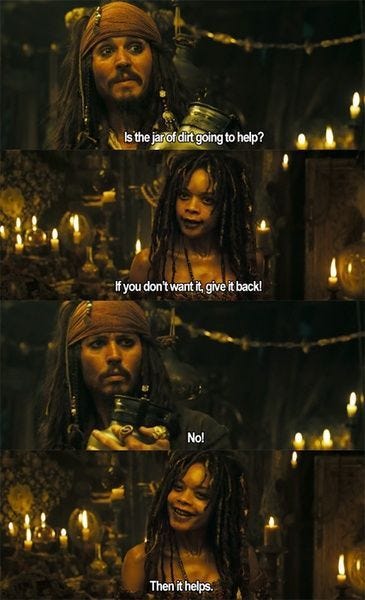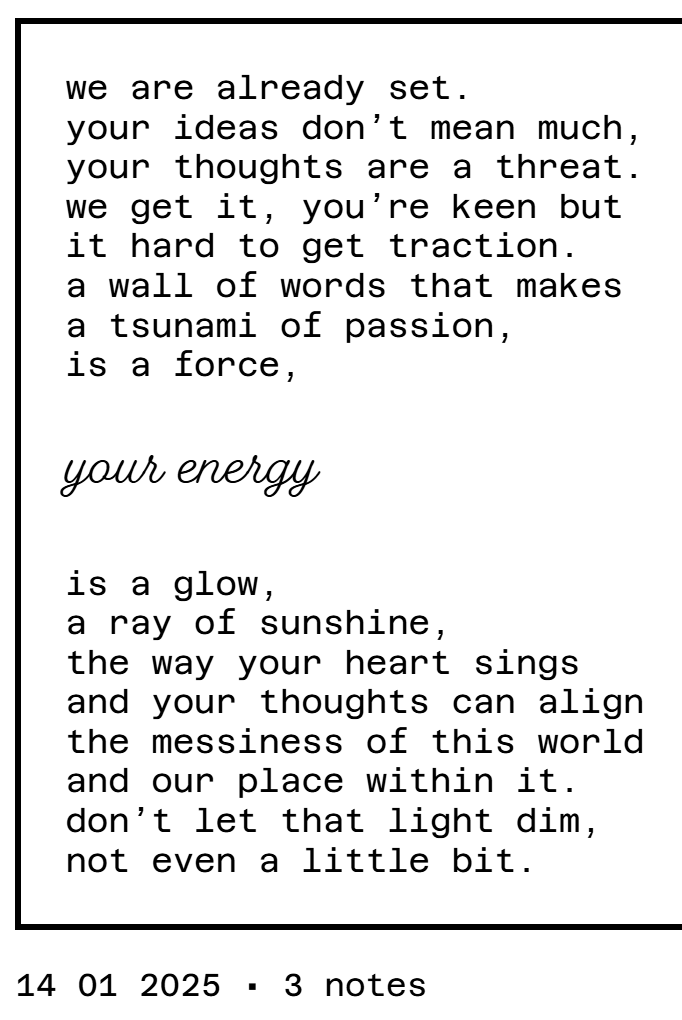this is how it all started.
i am renowned for themed presentations now, and it all started with this little video game-inspired poster in 2020. I mean, how could I walk past a pun like that!?
so when it came time to write my presentation for the Cluster for Research in Coaching conference about my time as a grassroots coach developer, i knew i had to run with a bolder idea.
there was a moment during coach education courses where it felt like we were selling dirt. to those in the room, who were open and curious and keen enough to join us on a learning journey, they understood the power of this jar - the protective element of what it held, meant, represented.
this little moment from the movie popped into my mind as i reflected on those courses. ultimately, this is all we wanted: to provide something that made people feel less alone in their role of the voluntold coach. it’s hard enough to take responsibility of 11 lives (often reluctantly just so the team could go ahead) in a complex sport - you shouldn’t have to do that alone. one of the benefits of having such an integral role to support coach learning in grassroots sport meant that we manufactured, and were expected to deliver, so many opportunities to connect with everyday coaches (parents). who wouldn’t want to come along and learn how to coach cricket when training each day feels like this…
… less people than you think. i mean, we had a good run and saw ~ 600 participants over 2 years (which likely included the same people multiple times) - but out of the ~1500 registered coaches per year, that felt a little light on. and the retention numbers would scream that we needed to do something for the quality of coaching because sports around the country are losing >50% participants per year and within our sport, ~38% was due to coaching. now, i wouldn’t be surprised if that number is underreported because who is going to fill out a ‘why did you quit’ survey and say your own parent wasn’t a good coach…
i will spend more time on another day unpacking the nature that our entire sporting system is held up on the backs of reluctant people who often just want the best for their child and are trying their best. i’ve also spoken about the dangers of ‘making someone’ do a course and the horcrux i created in the form of a ‘coaching manual’ before, so i wont rehash them here but i did have fun likening the ‘need for drills’ to this culty moment:
there is a moment in the presentation where i wanted to highlight the messiness of it all in one slide, so i blurted out the topics that haunted me the most while navigating the tension between the incredible things we’ve learned from research and the stark reality of what we met in practice. It is best read as a rambling, no breaks for breath kind of soliloquy which i verbalised while pacing the front of the room:
we’re supposed to meet people where they are at but what if they’re not thinking at all, what if all they want is for us to tell them what to do? and then, if we do, the first question we get is “who are you to tell me what to do” while they walk straight past me to my male colleague and greet him gracefully before finally acknowledging my presence, so we can give them the information they think they want but we know information about something doesn’t always help the 'doing’ and you can’t give concrete answers to fluid problems but the discomfort in uncertainty is overwhelming and of course these parents don’t have to time to plan a session but what if you didn’t have to? what if the questions were more around what needs to be real to make training engaging and enjoyable, what do i need to change when it stops working, and no, playing the game is not the same as helping people learn (especially in cricket) so please don’t make 10 children stand in the field and not touch the ball for 40 minutes.
this gif hit a little too close to home when I found it.
in the same way that our logical conclusion from that ramble was about helping more people in context. if we can’t bring the real world to you, why don’t we meet you in yours! funnily enough, even when we were invited in and always positioned ourselves as ‘an extra set of hands to help’, this was often the reaction…
we have tried so many ways to bring the learning to the learner, and there’s an interesting ethical dance here of helping people realise that maybe their practice doesn’t have the outcome they intended. we know that coaching practices don’t always match what coaches say about their practice, but there’s something especially difficult about watching someone assign push ups to a child (in 2025!?!?) for being too eager to participate in the activity and moving before they’re ‘supposed to’. they hadn’t touched the ball in the last 10 minutes so frankly, i don’t blame them for trying to bend the rules of the game.
through directors of coaching, casual staff, season inductions, whole-club training nights, virtual apprenticeship programs and a funded mentoring program that nobody signed up for, it was exasperating to say the least. by the book, we were trying to do everything right, and even if we couldn’t get it right, we were in action. run a course for 2 people, after driving 100km to get there? absolutely yes. why not. that’s two people who will hopefully have a positive experience and come back again with even more people.
the funny thing is, there’s no amount of graphs or statistics to convince people that what they are doing now isn’t working. we even tapped into the emotional side, sitting in a silent room when asked to share a ‘positive moment of being coached’ and very few people having anything to say. an ominous, heavy silence that we would use as a call to action.
to try and really ‘give the people what they want’, we tried reframing why you should attend a course at all: to problem solve together. bring your biggest frustrations and worries, and the collective wisdom of the room will help you through it. we’ll even throw in some design principles and frameworks so you can keep changing it up as you go. although we didn’t get to the point where we could (co)design an entire curriculum, a starter pack seemed the way to go. there is still so much risk in that concept alone, where a static physical document becomes outdated the moment it’s printed, but you cannot deny that having something to hold can calm the nerves.
we often tout that players ‘can’t get better if they don’t want to come back’ but we forgot this applies to the coaches too. now, i wasn’t willing to yield on some of the things people thought they needed, and i didn’t have the time nor energy to spark a societal and ontological shift towards meeting and greeting the uncertainty of the world we live in. the question remains, how do we balance the need to give people something to hold onto, without it becoming the blindfold that they cant/wont take off, at the cost of generations of children falling out of love with moving their bodies?
i don’t know.
i’m okay with that for now.
i may not be in the role anymore but i wont stop trying.
as a credit to the amazing community at CRiC, i felt comfortable sharing a poem that i wrote about the experience. it was inspired by the numerous comments i would receive from various stakeholders throughout a week - some of which drove me to keeping a ‘why do we bother’ tally (for how many times i asked myself that question) and the more uplifting, hopeful comments.
to read this poem, start in the middle with ‘your energy’ and read up, line by line. then, return to the middle again and read down.
you can find a copy of the slide deck here.
i also wanted to recommend this achingly brilliant but difficult video to watch, which spoke to me very deeply.
so many more stories to come from my 3 weeks in scandinavia, but in the meantime please enjoy this adorable photo of Sven (my travelling moose).














